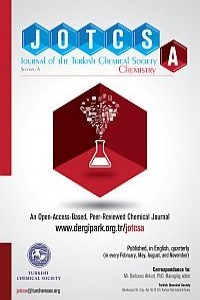Essential Oil Composition Of Two Scutellaria species from Tokat, Turkey
The genus Scutellaria L. (Lamiaceae) is represented in Turkey by 16 species, 1 natural hybrid, 38 taxa, 16 being endemic in Turkey (1,2). Hydrodistilled essential oils of the aerial parts of Scutellaria altissima L. and Scutellaria orientalis L. subsp. pinnatifida Edmondson were analyzed by GC and GC-MS systems, simultaneously. The oil of S. altissima contained β-caryophyllene (34.7 %), caryophyll-5-en-12-al (14.4%), linalool (14.3%) and hexadecanoic acid (7.1%) as main constituents. The oil of S. orientalis L. subsp. pinnatifida was characterized by the occurrence of germacrene D (56.9%), β-caryophyllene (10.5%) and bicyclogermacrene (10.1%) as major components. To the best of our knowledge, this is the first report on the GC and GC/MS determination of the essential oil composition of the S. altissima and S. orientalis subsp. pinnatifida species studied.
___
- 1. Cicek, M. (2012). Scutellaria L. In: Güner, A., Aslan, S., Ekim, T., Vural, M., Babac¸ M. T. (eds.). List of Turkish Flora (Vascular Plants)-Türkiye Bitkileri Listesi (Damarlı Bitkiler). Nezahat Gökyigit Botanik Bahcesi ve Flora Arastırmaları Dernegi Yayını. Istanbul, 582-585.
- 2. Edmondson J.R. (1982). Scutellaria L. In: Davis P.H.(Ed.) Flora of Turkey and the East Aegean Islands, Edinburgh: University Press, 7:78-100.
- 3, Paton, A. (1990). A global taxonomic investigation of Scutellaria (Labiatae). Kew Bulletin, 45, 399–450.
- 4. Baytop, T. (1999). Therapy with medicinal plants in Turkey (past and present) (2nd ed.). Istanbul: Nobel Tıp Kitabevleri.
- 5. Ozcelik, H., Ay, G., & Ozturk, M. (1990). Some traditional plants of East and Southeast Anatolia. Paper presented at the 10th National Symposium on Biology, Erzurum, Turkey, July 1990.
- 6. Calis, I., Saracoglu, I., Basaran, A. A., & Sticher, O. (1993). Two phenethyl alcohol glycosides from Scutellaria orientalis subsp. pinnatifida. Phytochemistry, 32(6), 1621-1623.
- 7.Shang, X., He, X., He, X., Li, M., Zhang, R., Fan, P.& Jia, Z. (2010). The genus Scutellaria an ethnopharmacological and phytochemical review. Journal of Ethnopharmacology, 128(2), 279-313.
- 8.Adams, R.P. (2007). Identification of Essential Oil Components by Gas Chromatography/Mass Spectrometry. Allured Publ. Corp, Carol Stream, IL.
- 9.Hochmuth, D. H. (2008). MassFinder-4, Hochmuth Scientific Consulting, Hamburg, Germany.
- 10. McLafferty, F.W., Stauffer, D.B. (1989). The Wiley/NBS Registry of Mass Spectral Data, J.Wiley and Sons: New York.
- 11. Curvers, J., Rijks, J., Cramers, C., Knauss, K., Larson, P. (1985). Temperature pro-grammed retention indexes: calculation from isothermal data. Part 1: Theory.Journal of High Resolution Chromatography 8, 607–610.
- 12. Formisano, C., Rigano, D., Senatore, F., Piozzi, F., & Arnold, N. A. (2011). Analysis of essential oils from Scutellaria orientalis ssp. alpina and S. utriculata by GC and GC-MS. Natural product communications, 6(9), 1347-1350.
- 13. Icen, M. S., Arabacı, T., Kostekci, S., & Gurhan, I. (2016). Chemical Composition of the Essential Oil of Scutellaria orientalis L. subsp. virens (Boiss. &Kotschy) JR Edm. from Turkey. Hacettepe J. Biol. & Chem., 44 (1), 25–28.
- 14. Delnavazi, M. R., Baba-Ali, F., Soufiabadi, S., Sherafatmand, M., Ghahremani, F., Tavakoli, S., & Yassa, N. (2014). Essential oil composition, antioxidant activity and total phenolic content of some Lamiaceae taxa growing in Northwest of Iran. Pharmaceutical sciences, 20(1), 22.
- Başlangıç: 2014
- Yayıncı: Türkiye Kimya Derneği
Sayıdaki Diğer Makaleler
Aysema SAYIK MEHAN, Ebru SENTURK, Emel MATARACI KARA, Ayse Serguzel YUSUFOGLU
Meryem KALKAN ERDOĞAN, Meral KARAKIŞLA
Meryem KALKAN ERDOĞAN, Meral KARAKIŞLA
Hussein Kehinde OKORO, Oluwaseyi AYİKA, Adedibu TELLA, Jane NGİLA
Ikechukwu Alisi, Adamu UZAİRU, Stephen Eyije ABECHİ, Suleiman Ola IDRİS
Sabriye PERÇİN ÖZKORUCUKLU, Besnik UKA, Gizem YILDIRIM BAŞTEMUR
Aysema SAYIK MEHAN, Ebru SENTURK, Emel MATARACI KARA, Ayse Serguzel YUSUFOGLU
Rachid HSİSSOU, Mohamed BERRADİ, Mehdi EL BOUCHTİ, Ahmed EL HARFİ
